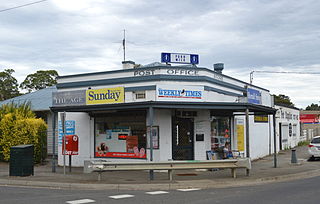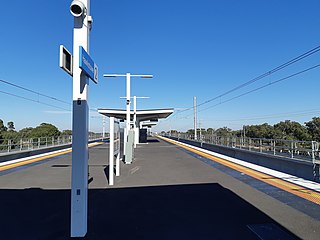
The City of Whittlesea is a local government area located in the outer northern suburbs of Melbourne, the state capital of Victoria, Australia. The city covers an area of 490 square kilometres (189.2 sq mi), and in June 2018, it had a population of 223,322.

Docklands, also known as Melbourne Docklands, is an inner-city suburb in Melbourne, Victoria, Australia, 2 km (1.2 mi) west of Melbourne's Central Business District, located within the City of Melbourne local government area. Docklands recorded a population of 15,495 at the 2021 census.

The Royal Melbourne Institute of Technology is a public research university in Melbourne, Australia.

Bundoora is a suburb in Melbourne, Victoria, Australia, 15 km (9.3 mi) north-east of Melbourne's Central Business District, located within the Cities of Banyule, Darebin and Whittlesea local government areas. Bundoora recorded a population of 28,068 at the 2021 census.
Kingsbury is a suburb in Melbourne, Victoria, Australia, 12 km (7.5 mi) north-east of Melbourne's Central Business District, located within the City of Darebin local government area. Kingsbury recorded a population of 3,460 at the 2021 census.

Preston is a suburb in Melbourne, Victoria, Australia, 9 km (5.6 mi) north-east of Melbourne's central business district, located within the City of Darebin local government area. Preston recorded a population of 33,790 at the 2021 census.

Reservoir is a suburb in Melbourne, Victoria, Australia, 12 km (7.5 mi) north of Melbourne's Central Business District, located within the City of Darebin local government area. Reservoir recorded a population of 51,096 at the 2021 census.

Doreen is a rapidly growing suburb in Melbourne, Victoria, Australia, 29 km (18 mi) north-east of Melbourne's Central Business District, located within the City of Whittlesea and Shire of Nillumbik local government areas. Doreen recorded a population of 27,122 at the 2021 census.

Lalor is a suburb in Melbourne, Victoria, Australia, 17 km (11 mi) north of Melbourne's Central Business District, located within the City of Whittlesea local government area. Lalor recorded a population of 23,219 at the 2021 census.

Merri railway station is located on the Mernda line in Victoria, Australia. It serves the north-eastern Melbourne suburb of Northcote, and it opened on 8 October 1889 as Northcote. It was renamed Merri on 10 December 1906.
Mill Park is a suburb of Melbourne, Victoria, Australia, 18 km north-east of Melbourne's central business district, located within the City of Whittlesea local government area. Mill Park recorded a population of 28,712 at the 2021 census.

Mernda is a suburb of Melbourne, Victoria, Australia, 26 km north-east of Melbourne's central business district, located within the City of Whittlesea local government area. Mernda recorded a population of 23,369 at the 2021 census.

South Morang railway station is located on the Mernda line in Victoria, Australia. It serves the north-eastern Melbourne suburb of the same name, and opened on 22 April 2012.

Mernda railway station is the terminus of the suburban electrified Mernda line in Victoria, Australia. It serves the north-eastern Melbourne suburb of Mernda, and it opened on 26 August 2018.

MAB Corporation is an integrated property company that creates, owns and manages property assets and built environments throughout Australia. The company was founded in 1995 by Michael Buxton, who began his career working in his family's business, and Andrew Buxton, who started out working in the quarry and asphalt industry.

The Shire of Diamond Valley was a local government area about 20 kilometres (12 mi) northeast of Melbourne, the state capital of Victoria, Australia. The shire covered an area of 74.38 square kilometres (28.72 sq mi), and existed from 1964 until 1994.
Numerous proposals have been made for improvements to the Melbourne tram network, the largest such network in the world. Nearly all of these have been for track extensions of existing lines to connect with nearby railway station or to service new areas and suburbs.

Hawkstowe railway station is located on the Mernda line in Victoria, Australia. It serves the north-eastern Melbourne suburb of South Morang, and it opened on 26 August 2018.
Plenty Road is a major urban arterial road in the north-eastern suburbs of Melbourne, Victoria, Australia. Plenty Road begins at the intersection of High Street and Dundas Street in Preston, travelling through the north eastern suburbs of Reservoir, Bundoora, Mill Park, South Morang and Mernda and terminating in the township of Whittlesea, just outside the urban area of Melbourne.















